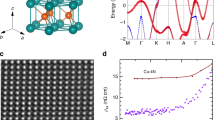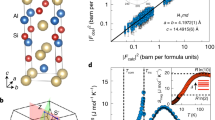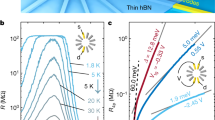Abstract
Weyl fermions1,2,3 have been observed as three-dimensional, gapless topological excitations in weakly correlated, inversion-symmetry-breaking semimetals4,5. However, their realization in spontaneously time-reversal-symmetry-breaking phases of strongly correlated materials has so far remained hypothetical2,6,7. Here, we report experimental evidence for magnetic Weyl fermions in Mn3Sn, a non-collinear antiferromagnet that exhibits a large anomalous Hall effect, even at room temperature8. Detailed comparison between angle-resolved photoemission spectroscopy (ARPES) measurements and density functional theory (DFT) calculations reveals significant bandwidth renormalization and damping effects due to the strong correlation among Mn 3d electrons. Magnetotransport measurements provide strong evidence for the chiral anomaly of Weyl fermions—namely, the emergence of positive magnetoconductance only in the presence of parallel electric and magnetic fields. Since weak magnetic fields (approximately 10 mT) are adequate to control the distribution of Weyl points and the large fictitious fields (equivalent to approximately a few hundred T) produced by them in momentum space, our discovery lays the foundation for a new field of science and technology involving the magnetic Weyl excitations of strongly correlated electron systems such as Mn3Sn.
This is a preview of subscription content, access via your institution
Access options
Access Nature and 54 other Nature Portfolio journals
Get Nature+, our best-value online-access subscription
$29.99 / 30 days
cancel any time
Subscribe to this journal
Receive 12 print issues and online access
$259.00 per year
only $21.58 per issue
Buy this article
- Purchase on Springer Link
- Instant access to full article PDF
Prices may be subject to local taxes which are calculated during checkout



Similar content being viewed by others
References
Nielsen, H. B. & Ninomiya, M. The Adler-Bell-Jackiw anomaly and Weyl fermions in a crystal. Phys. Lett. B 130, 389–396 (1983).
Wan, X., Turner, A. M., Vishwanath, A. & Savrasov, S. Y. Topological semimetal and Fermi-arc surface states in the electronic structure of pyrochlore iridates. Phys. Rev. B 83, 205101 (2011).
Burkov, A. A. & Balents, L. Weyl semimetal in a topological insulator multilayer. Phys. Rev. Lett. 107, 127205 (2011).
Xu, S.-Y. et al. Discovery of a Weyl fermion semimetal and topological Fermi arcs. Science 349, 613–617 (2015).
Lv, B. Q. et al. Experimental discovery of Weyl semimetal TaAs. Phys. Rev. X 5, 031013 (2015).
Witczak-Krempa, W., Chen, G., Kim, Y. B. & Balents, L. Correlated quantum phenomena in the strong spin-orbit regime. Annu. Rev. Condens. Matter Phys. 5, 57–82 (2014).
Wang, Z. et al. Time-reversal-breaking Weyl fermions in magnetic Heusler alloys. Phys. Rev. Lett. 117, 236401 (2016).
Nakatsuji, S., Kiyohara, N. & Higo, T. Large anomalous Hall effect in a non-collinear antiferromagnet at room temperature. Nature 527, 212–215 (2015).
Hasan, M. Z. & Kane, C. L. Colloquium: topological insulators. Rev. Mod. Phys. 82, 3045–3067 (2010).
Liu, Z. et al. Discovery of a three-dimensional topological Dirac semimetal, Na3Bi. Science 343, 864–867 (2014).
Neupane, M. et al. Observation of a three-dimensional topological Dirac semimetal phase in high-mobility Cd3As2 . Nat. Commun. 5, 4786 (2014).
Yang, K.-Y., Lu, Y.-M. & Ran, Y. Quantum Hall effects in a Weyl semimetal: possible application in pyrochlore iridates. Phys. Rev. B 84, 075129 (2011).
Zhong, S., Orenstein, J. & Moore, J. E. Optical gyrotropy from axion electrodynamics in momentum space. Phys. Rev. Lett. 115, 117403 (2015).
Son, D. T. & Spivak, B. Z. Chiral anomaly and classical negative magnetoresistance of Weyl metals. Phys. Rev. B 88, 104412 (2013).
Goswami, P., Pixley, J. H. & Das Sarma, S. Axial anomaly and longitudinal magnetoresistance of a generic three-dimensional metal. Phys. Rev. B 92, 075205 (2015).
Xiong, J. et al. Evidence for the chiral anomaly in the Dirac semimetal Na3Bi. Science 350, 413–416 (2015).
Huang, X. et al. Observation of the chiral-anomaly-induced negative magnetoresistance in 3D Weyl semimetal TaAs. Phys. Rev. X 5, 031023 (2015).
Zhang, C.-L. et al. Signatures of the Adler-Bell-Jackiw chiral anomaly in a Weyl fermion semimetal. Nat. Commun. 7, 10735 (2016).
Hirschberger, M. et al. The chiral anomaly and thermopower of Weyl fermions in the half-Heusler GdPtBi. Nat. Mater. 15, 1161–1165 (2016).
Tomiyoshi, S. Polarized neutron diffraction study of the spin structure of Mn3Sn. J. Phys. Soc. Jpn 51, 803–810 (1982).
Brown, P., Nunez, V., Tasset, F., Forsyth, J. & Radhakrishna, P. Determination of the magnetic structure of Mn3Sn using generalized neutron polarization analysis. J. Phys. Condens. Matter 2, 9409–9422 (1990).
Suzuki, M.-T., Koretsune, T., Ochi, M. & Arita, R. Cluster multipole theory for anomalous Hall effect in antiferromagnets. Phys. Rev. B 95, 094406 (2017).
Nagaosa, N., Sinova, J., Onoda, S., MacDonald, A. H. & Ong, N. P. Anomalous Hall effect. Rev. Mod. Phys. 82, 1539–1592 (2010).
Kiyohara, N., Tomita, T. & Nakatsuji, S. Giant anomalous Hall effect in the chiral antiferromagnet Mn3Ge. Phys. Rev. Appl. 5, 064009 (2016).
Yang, H. et al. Topological Weyl semimetals in the chiral antiferromagnetic materials Mn3Ge and Mn3Sn. New J. Phys. 19, 015008 (2017).
Soluyanov, A. A. et al. Type-II Weyl semimetals. Nature 527, 495–498 (2015).
McGuire, T. R. & Potter, R. I. Anisotropic magnetoresistance in ferromagnetic 3d alloys. IEEE Trans. Magn. 11, 1018–1038 (1975).
Pippard, A. B. Magnetoresistance in Metals (Cambridge Univ. Press, 1989).
Zyuzin, V. A. Magnetotransport of Weyl semimetals due to the chiral anomaly. Phys. Rev. B 95, 245128 (2017).
Landsteiner, K. Anomalous transport of Weyl fermions in Weyl semimetals. Phys. Rev. B 89, 075124 (2014).
Giannozzi, P. et al. QUANTUM ESPRESSO: a modular and open-source software project for quantum simulations of materials. J. Phys. Condens. Matter 21, 395502 (2009).
Acknowledgements
This work was supported by CREST (JPMJCR15Q5), Japan Science and Technology Agency, Grants-in-Aid for Scientific Research (Grant Nos. 16H02209, 25707030), by Grants-in-Aid for Scientific Research on Innovative Areas ‘J-Physics’ (Grant Nos. 15H05882 and 15H05883), and ‘Topological Materials Science’ (Grant No. 16H00979), and Grants-in-Aid for Young Scientists A (Grants No. 16H06013) and B (Grants No. 17K14319), and Grant-in-Aid for Exploratory Research (Grants No. 16K13829), and Program for Advancing Strategic International Networks to Accelerate the Circulation of Talented Researchers (Grant No. R2604) from the Japanese Society for the Promotion of Science, and Photon and Quantum Basic Research Coordinated Development Program from the Ministry of Education, Culture, Sports, Science and Technology, Japan. P.G. was supported by JQI-NSF-PFC and LPS-MPO-CMTC. The use of the facilities of the Materials Design and Characterization Laboratory at the Institute for Solid State Physics, The University of Tokyo, is gratefully acknowledged. We thank S. Kunisada, M. Sakano and E. Golias for technical supports to perform ARPES measurements. The soft X-ray synchrotron radiation experiments were performed with the approval of JASRI (Proposal Nos. 2015B2002, 2016A1296, 2016B1262). The vacuum ultraviolet experiments were performed under the approval of the Photon Factory Program Advisory Committee (Proposal No. 2016G622). We thank Helmholtz-Zentrum Berlin (HZB) for the allocation of synchrotron radiation beam time.
Author information
Authors and Affiliations
Contributions
S.N. planned the experimental project. K.K. and C.B., conducted the ARPES experiment and analysed the data. M.N., S.A., R.N., S.S., T.Kondo, N.I., K.O., H.K., T.M. and A.V. supported the ARPES experiment. A.A.N., M.I. and S.N. made the Mn3Sn single crystals and carried out their characterization. R.I. performed chemical analyses. T.T., M.I. and S.N. performed transport experiments and collected data. P.G. provided theoretical insights. M.-T.S., T.Koretsune, M.O. and R.A. calculated the band structure. K.K., T.T., P.G., R.A. and S.N. wrote the paper. All the authors discussed the results and commented on the manuscript.
Corresponding author
Ethics declarations
Competing interests
The authors declare no competing financial interests.
Supplementary information
Supplementary Information
Supplementary Information (PDF 2951 kb)
Rights and permissions
About this article
Cite this article
Kuroda, K., Tomita, T., Suzuki, MT. et al. Evidence for magnetic Weyl fermions in a correlated metal. Nature Mater 16, 1090–1095 (2017). https://doi.org/10.1038/nmat4987
Received:
Accepted:
Published:
Issue Date:
DOI: https://doi.org/10.1038/nmat4987
This article is cited by
-
Sub-cycle multidimensional spectroscopy of strongly correlated materials
Nature Photonics (2024)
-
Magnetism and fermiology of kagome magnet YMn6Sn4Ge2
npj Quantum Materials (2024)
-
Weyl metallic state induced by helical magnetic order
npj Quantum Materials (2024)
-
Room-temperature flexible manipulation of the quantum-metric structure in a topological chiral antiferromagnet
Nature Physics (2024)
-
Absence of metallicity and bias-dependent resistivity in low-carrier-density EuCd2As2
Science China Physics, Mechanics & Astronomy (2024)



